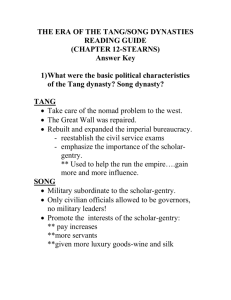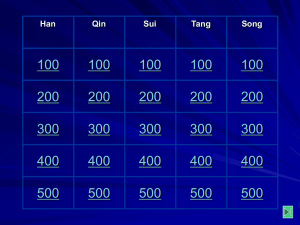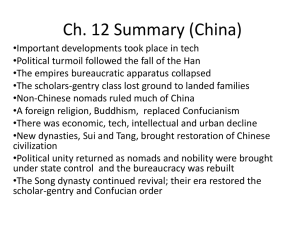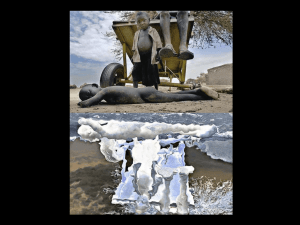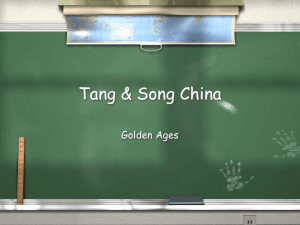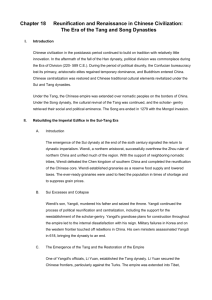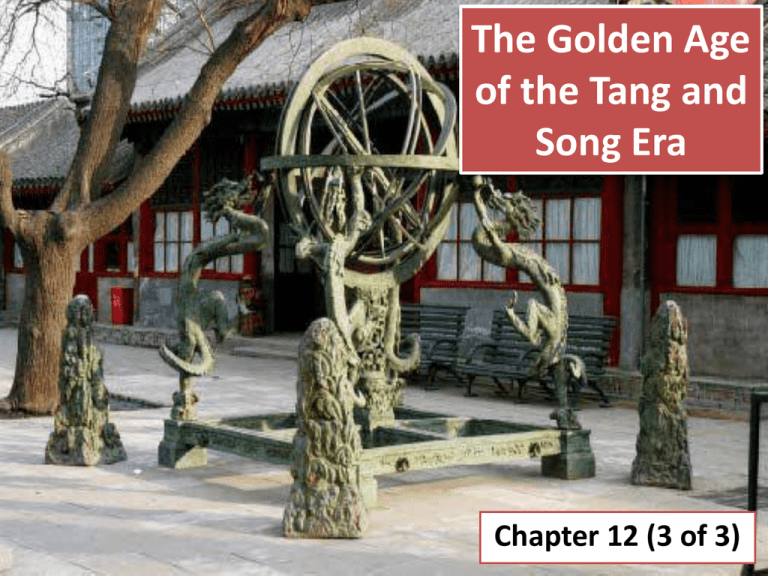
The Golden Age
of the Tang and
Song Era
Chapter 12 (3 of 3)
The Grand Canal
Along with other canals, the
Grand Canal linked north
China (plains) and south China
(Yangtze River basin), vital to
economic growth
Huge amount of people move
to south China, where most of
the food for the empire was
grown
By the time the Song took over
in the 900s, the population of
southern China was more than
that of north China
Silk Roads
reopened (China
sent silk, porcelain,
and paper in
exchange for horses
and Persian rugs
and tapestries
Trade Grows
Trade with S.E. Asia
also increased (China
sent manufactured
goods in exchange for
luxury goods
(aromatic woods and
spices)
Tang army conquered much of central Asia leading to
the growth of trade and commerce
Junks = Chinese ships
that was very advanced
with sails, compasses,
and even rockets for
defense
Along with Arab dhows,
junks were the best
ships in the world
during the postclassical
period
A New Kind of Money System
Changes to
the money
system led
to an
increase in
trade and
commerce
Banks (called deposit shops) were
created so merchants could borrow
money to fund business growth
Paper money began to be used which
made it easier to buy and sell products,
especially from one town to another
Flying money = credit vouchers, so
merchants didn’t have to carry cash; less
chance of being robbed, trade increased
Markets Grow
Government supervised
markets spring up in
every city in China
Though controlled by
the government, local
guilds existed in many
cities (similar to
western Europe)
China Had the Most Big Cities
During Tang-Song era, Changan, the capital,
many cities had over
had over 2 million
100,000 people (most people, making it the
civilizations had a few
largest city in the
at most)
world at the time
10% of Chinese lived
in cities, by far the
largest percentage of
any civilization in the
world at the time
As Cities Grew, So Did Agriculture
As Chinese population moved south during the postclassical
era (to Yangtze River basin), agricultural expansion occurred
Government helped agricultural growth by encouraging
settlement of unfarmed land, and creating irrigation systems
New types of seeds, better use of animal and human
manure, new technology such as wheelbarrow, also helped
Aristocracy Further Weakened
As a result, scholar-gentry
Tang government broke
becomes even more
up aristocratic estates
powerful (lived in homes
and gave land to peasants
with curved roofs, a
status symbol in China)
This was done to curb
power of aristocrats
(remember: scholargentry now had power)
and to help peasants
Family Life
Confucian teachings (which dominated
the later Tang era and the Song era,
taught traditional views (men head of
family and respect for elders)
Did You Know: The
penalty for a child
hitting a parents
was beheading of
the child
Women - At
st
1
In early Tang Dynasty, position of
women improving (Buddhist ideas
had influence over Confucianism)
Example of rights women gained in
early Tang era:
1. Had some political power (like
Empress Wu)
2. Lots of activities open (ex: could
play polo)
3. Divorce laws helped women
somewhat
4. Women could take lovers with
knowledge of husband
Okay But…
Still had arranged
marriages (like India)
with bride’s family paying
dowry to husband’s
family
Difference was in China,
the pair getting married
were usually same age
(Confucian idea of
separation of
generations), and often
the pair were older than
those married in India
By Late Song
Era, Women’s
Status Bad
Neo-Confucians began taking over (as Buddhists lost power) and
subordinate position of women returned
Women are confined to the
household and had no career
opportunities
Like in India, women no longer
allowed to marry after husband
died
Women were expected to
refrain from sex (especially
before marriage), men were not
Laws favored men in
inheritance, and women were
excluded from education
Footbinding = Chinese women
had toes curled back and bound to
create smaller looking foot
Bound feet were painful and
Mothers had daughter’s feet
limited a women’s mobility (a way bound b/c only way to find a good
to confine them to the home)
husband was with bound feet
Tang and Song Era
Considered a Golden
Age of Chinese
Artistic and Scientific
Advancement
Economy grew for several
reasons, including new
technology and innovations
(irrigation projects, canal
system, paper money, etc.)
Gunpowder
At 1st not for war (only fireworks)
Later on it was used in war
More New Technology
Compasses used for sea travel
Abacus invented for doing
mathematical calculations, helped
merchants and also helped tax
collection
Kites flown for the first time
Movable type = allowed books and
written records to be made more
easily (big reason why literacy high in
China compared to other preIndustrial societies)
Scholar-gentry
replaced Buddhists as
the ones creating new
art and literature
This resulted
every day life
and nature
themes
replacing
religious
themes
Li Bo
Most famous poet of
the Tang era,
combined images of
everyday life with
philosophical
thoughts (similar to
Persian authors)
Song era art known for its landscape painting
Song Sung Blue – The Song Ends Here
1. Song fled south to avoid nomadic attacks (Jurchens)
2. Could not avoid the Mongols and Chinggis Khan (though
for a while, Song able to survive by paying him tribute)
3. By 1279, Kubilai Khan conquered the Song and ended
the dynasty
4. Mongols were very powerful, so although the Song
defeated, Mongols able to keep China somewhat united,
so it did not experience another Era of Division
Tang-Song Dynasty Pivotal to China’s History
1. Bureaucracy restored as scholar-gentry gained
power over aristocrats, Buddhists, and nomads
2. Chinese civilization grew dramatically as south
was united with the north
3. China’s economy became one of the strongest in
the world, and would remain that way until the
1700s

